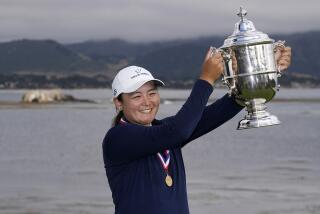After Plunge From No. 1, Bradley Closing In on Cure
At the moment, Pat Bradley stands 103rd on the LPGA money list, so far down that everything looks like up to her. Sheâs made $12,000 this year. Two years ago, when she was Player of the Year, she won $492,000. She hasnât won a tournament in 15 months. Two years ago she won five, but more impressive, Bradley won three of the four majors. No female golfer ever had a year like she had in 1986. Now, if she was any deeper, sheâd be breathing through a snorkel. Some people might look at Pat Bradleyâs astonishing plunge and assume her success went to her head. Actually, it stopped at her neck.
She has hyperthyroidism. She had it for a full year before it was diagnosed this April. She was grateful to find out it was something physically wrong with her. She thought she was having a nervous breakdown.
âIn 1986 I became what Iâd strived for, and lived and died for, every year Iâd been on the tour: Player of the Year,â Bradley said, her words tumbling out in the husky telltale accent of her native New Hampshire. Sheâd been around the hole for so long--9 of 10 years a top-10 money winner from 1976 to 1985--until the breakthrough in 1986. âIâd put all my eggs in one basket. I was singlemindedly obsessed with Player of the Year. It took me 13 years to get it. So when â86 came and went, and Iâd done it, it was like: Now what do I do? My energies were so wrapped up, I didnât have anything left. It took me so long to get Player of the Year, I didnât want to let go.â
Because sheâd always been goal-oriented, Bradleyâs immediate problem was to come up with something to aim for in 1987. How on earth do you top $492,000 and a Three-Quarter Slam? âI thought I could win four of four majors,â she said, aiming not merely high but at the moon. âBut putting that kind of pressure on myself made it very tough on me.â
Midway through the year Bradleyâs game came apart like an orange, in sections. She missed fairways, missed greens, missed putts and every other week or so she missed the cut. She developed symptoms she didnât understand. âI got very jumpy, very racy, my heart rate was extremely increased. I was always hot, no matter what the temperature was; Iâd turn down the air conditioner to 30 degrees, but I was still sweating. And I was always out of breath.â Yet she âneverâ thought it was a physical problem. âHow could it be? Iâd just had the greatest year of my life.â
Bradley didnât consult friends or family, didnât see a psychiatrist, didnât say one word about her fears to anyone even as her game and her emotional state fell apart. âI kept it all to myself,â she said. âI didnât want to let my guard down. I didnât want to show anyone I was losing it--because I thought I was.â It was obvious to the players that Bradleyâs game was a mess, but nobody knew what to say to her. âEveryone said, âBe tough. Youâre in a slump, play through it. Show them what youâre made of. Show some guts.â I tried to do that, because I certainly didnât want anyone to think I wasnât strong enough to handle this on my own. But the more I tried, the deeper I dug the hole.â
She became depressed and paranoid. âI was so hyper,â she said. âOn the tee, if I was first, Iâd put the ball in the ground seven or eight minutes before my name was announced. My swing was so fast, it would put out a forest fire. I had to change my putting stance--keep my knees locked--because my body was shaking so much I got paranoid that everyone noticed.â Why was this happening to her? âI thought maybe I might be going through the change of life,â she said, blushing at the thought. âThe old saying in golf is that the nerves are the first to go, but my God, Iâm only 37 years old.â
Desperately confused, Bradley finally sought medical help. Bradley laughed as she recalled that it took Dr. Ronald Garvey only a half hour to diagnose the hyperthyroidism, the same condition that afflicts Ben Crenshaw. (Later, Bradley and Garvey played a round of golf for his medical bill; she won, and walked away even.) âA whole year went by,â Bradley said regretfully. âI was too stubborn to admit I could be vulnerable.â Garvey told Bradley the condition was triggered by stress, which surprised her because she figured sheâd coped rather well with stress during her career; professional golf is, after all, a highly stressful occupation, and Bradley had been preeminently successful at it. But she was relieved by the diagnosis, admitting, âI was hoping there was something drastically wrong, or I didnât see how I could go on playing golf.â
Recently, Bradley has been trying to achieve the right balance of medicine, so she can play golf without being negatively affected by either the condition or the cure. âI feel much, much better,â she said, âbut Iâm still up and down a bit.â She missed the cut at the last weekâs U.S. Open, but sheâs encouraged. âBefore I couldnât stand over a shot, I couldnât even drink a cup of water, my hands shook so. I had no strength, I was hitting an 8-iron 105 yards. I can go around the golf course now. Iâm stronger. I think the worst is over.â
Just in time, too. Next week, after her stop here at the Greater Washington Open, sheâll play in High Point, N.C., in the inauguration of the âPlanters Pat Bradley International.â Itâs a rare honor to have a tournament named for you; usually itâs reserved for the very rich, or the very dead. Six months ago, she wouldnât have made the cut at her own tournament. Now, with a new lease on her game, whoâs to say she wonât win it? âThat,â Pat Bradley said dreamily, âwould be a script made in heaven.â
More to Read
Go beyond the scoreboard
Get the latest on L.A.'s teams in the daily Sports Report newsletter.
You may occasionally receive promotional content from the Los Angeles Times.









